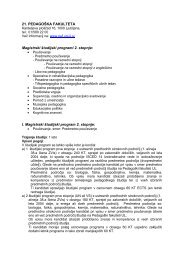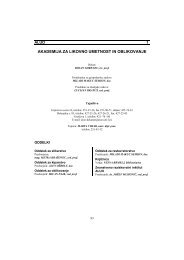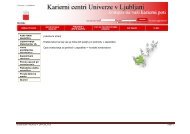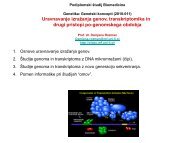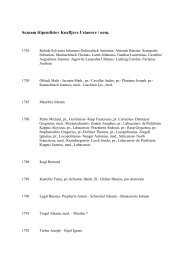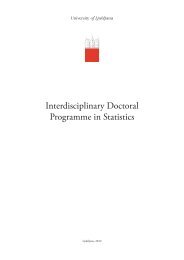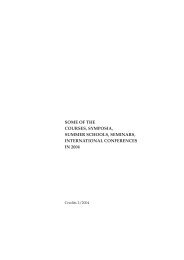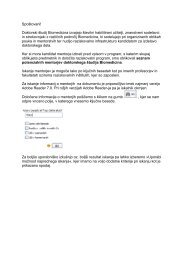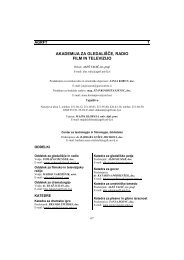Medicinska fakulteta Univerze v Ljubljani 1919–1945 - Univerza v ...
Medicinska fakulteta Univerze v Ljubljani 1919–1945 - Univerza v ...
Medicinska fakulteta Univerze v Ljubljani 1919–1945 - Univerza v ...
You also want an ePaper? Increase the reach of your titles
YUMPU automatically turns print PDFs into web optimized ePapers that Google loves.
esult of the forceful promotion of the tertiary education model<br />
in Austria that was based on the Bavarian model from the times<br />
of Joseph II� The two levels of this area of education: lyceum and<br />
“erudite” (university) level study gave an entirely new meaning in<br />
the non-German lands of the Monarchy to the small, philosophy-<br />
and theology-oriented, lyceum-type educational institutions<br />
throughout the provinces that were treated with mistrust by the<br />
enlightened reformers of the second half of the 18 th century�<br />
As opposed to the true universities involved in scientific work,<br />
lyceums focused predominantly on educating for professional<br />
(vocational) practice as their primary goal was the training of<br />
priests, who were supposed to possess practical agricultural<br />
knowledge in addition to the theological knowledge, as well as<br />
barber surgeons, managers of large estates and teachers� In this<br />
sense, lyceums were divided into degraded universities, which<br />
could only award doctoral degrees in philosophy and theology,<br />
and lyceums created as a type of stunted gymnasium that replaced<br />
the former Jesuit study and became scientific and educational<br />
institutions in provincial centres that, however, did not possess<br />
the right to award doctoral titles� The Ljubljana Lyceum was<br />
one of those that did not have the right to award academic titles<br />
and was a semi-university institution and represented a sort of<br />
intermediary link between a gymnasium and a true university� It<br />
provided three fields of study, namely the study of philosophy,<br />
medical-surgical studies and theological studies as well as a<br />
multitude of elective courses ranging from agriculture and history<br />
to philosophy and modern languages�<br />
II<br />
In the first half of the 19 th century, medicine could be studied<br />
at two levels� Surgical studies for civilian and rural barber<br />
surgeons (Chirurgische Studium für Civil- und Landwundärzte)<br />
lasted two years and were predominantly limited to surgery and<br />
obstetrics, which also included midwifery� Most of the lyceums<br />
did not exceed this scope of the learning on offer�<br />
The study of folk medicine and higher barber surgery (Studium der<br />
Arznaykunde und höheren Wundarznaykunst) lasted four years<br />
at first and could be completed within the Habsburg Monarchy at<br />
the famed universities in Vienna, Prague and Krakow�<br />
The faculty-level study of medicine was extended to five years<br />
in 1804 with the change of curriculum: instruction during the<br />
first three years involved theory, while years four and five were<br />
devoted to practical bedside instruction� The study of surgery<br />
remained a two-year programme, however, the teaching content<br />
was expanded somewhat, whereby they primarily strove to raise<br />
the quality of this vocational education�<br />
The study reform of 1810 increased the number of study courses<br />
at both levels of education� The individual parts of study gained<br />
a certain level of independence (chemistry, pharmacy, ophthal-<br />
98<br />
mology, dentistry, veterinary medicine and obstetrics)� It was<br />
veterinary medicine especially that achieved enviable success after<br />
the inclusion of the veterinary science institute (K.k. Thierarzney-<br />
Institut) in Vienna into the Vienna Faculty of Medicine in 1808�<br />
Enrolment to the Veterinary Medicine Department of the Vienna<br />
Faculty of Medicine was conditional upon the completion of the<br />
study of medicine (physician or barber surgeon)�<br />
The Faculty of Medicine was otherwise the only faculty to obtain<br />
a new curriculum in 1833� The study of surgery was extended to<br />
three years, while the study of pharmacy was extended to two<br />
years� The Court Study Commission was asking professors at the<br />
Faculty of Medicine as early as in 1836 what kind of improvements<br />
they would like to see� The proposals were gathered by<br />
Ludwig Freiherr von [Türkheim], deputy to the Study Director<br />
of the Vienna Medicine and Surgery Studies� His fundamental<br />
thought was “that the current arrangement, according to which<br />
two types of medical staff were being trained, namely physicians<br />
and barber surgeons (Doctors of Medicine and Surgery and<br />
Masters or Patrons of Surgery), was untenable from the scientific<br />
point of view”, which is why he proposed that they would “in the<br />
future train only one type of medical staff possessing the same<br />
level of education and training, namely Doctors of Medicine and<br />
Surger y”�<br />
In 1845, the Court’s Study Commission set up a special<br />
commission tasked with preparing a new curriculum� It was<br />
composed of Joseph Skoda, Karl Rokitansky and Joseph Hyrtel,<br />
while its clerk was Stephan Ladislaus Endlicher� The report<br />
compiled by this commission in 1846, which was not realised,<br />
also focused on future development�<br />
III<br />
Ljubljana already had three teachers teaching medical-surgical<br />
studies since the end of the 18 th century� One of them had to hold<br />
a PhD in medicine and taught simple botany, some chemistry and<br />
the Collegium Clinicum Arte Medica course as instruction on<br />
internal diseases� The second teacher taught anatomy and barber<br />
surgery with anatomy and obstetrics, while the third teacher<br />
taught veterinary science and was later tasked with also teaching<br />
forensic medicine� The two-year study course was divided into<br />
two parts� The first year dealt mostly with theory, especially<br />
anatomy and theoretical bases for other courses, while the second<br />
year included instruction on surgical operations, wound dressing<br />
and obstetrics, which allowed the students to practice bedside<br />
activities of “both surgery and internal medicine”�<br />
In the first Pre-March Period up to 1806, Dr� Karl Bernard Kogel<br />
taught internal medicine (instruction on diseases) and veterinary<br />
medicine, Dr� Vincenc Kern taught surgery, anatomy and obstetrics<br />
until 1805 (he later became a Professor of Surgery in Vienna), Dr�<br />
Franc Melzer taught surgery and midwifery until 1805 and Anton<br />
Melzer taught anatomy and physiology until 1806�



